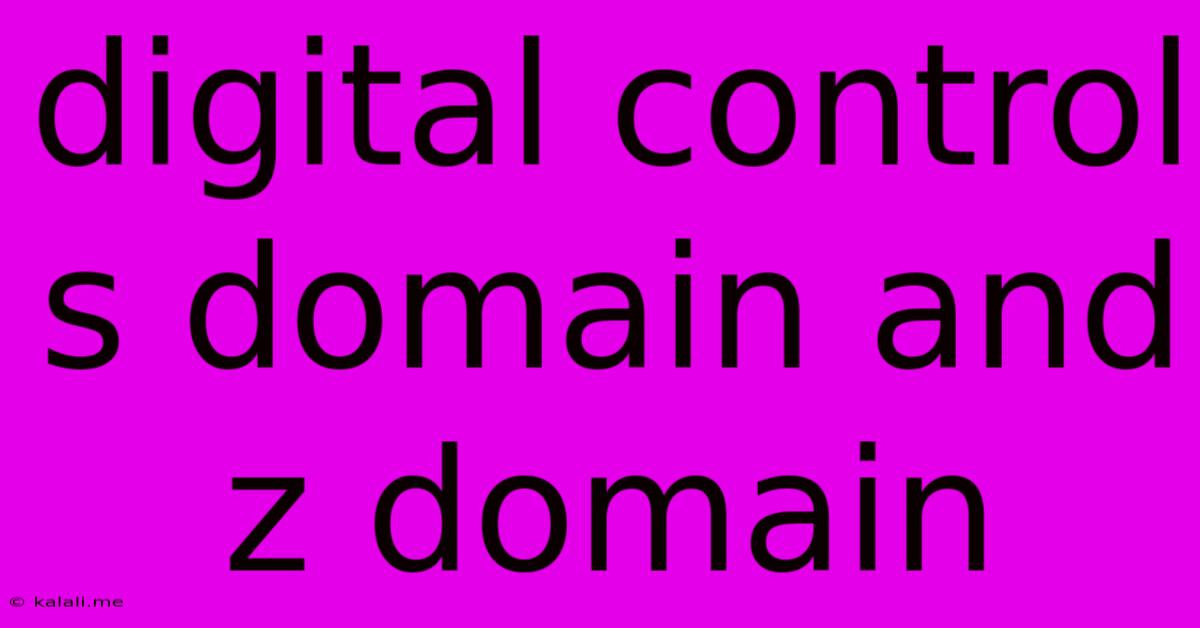Digital Control S Domain And Z Domain
Kalali
May 23, 2025 · 3 min read

Table of Contents
Digital Control: Understanding the s-Domain and z-Domain
Understanding the differences and relationships between the s-domain and the z-domain is crucial for anyone working with digital control systems. This article will delve into the core concepts of both domains, highlighting their similarities, differences, and applications in digital signal processing and control engineering. We'll explore how continuous-time systems (represented in the s-domain) are transformed into discrete-time systems (represented in the z-domain), and why this transformation is vital for practical digital implementation.
The s-domain, also known as the Laplace domain, is a mathematical tool used to analyze and design continuous-time systems. It transforms differential equations, which describe the behavior of continuous-time systems, into algebraic equations, simplifying analysis and design. The variable 's' represents the complex frequency, and the Laplace transform maps a time-domain function to its frequency-domain equivalent. Key concepts in the s-domain include transfer functions, poles, zeros, and stability analysis.
The z-domain, on the other hand, deals with discrete-time systems. It's the equivalent of the s-domain but for systems that operate on sampled data. The z-transform, analogous to the Laplace transform, converts a discrete-time sequence into a function of the complex variable 'z'. This transformation allows engineers to analyze and design digital controllers and filters effectively. Just like in the s-domain, concepts like transfer functions, poles, zeros, and stability analysis are crucial for understanding the behavior of z-domain systems.
Key Differences between s-Domain and z-Domain
| Feature | s-Domain (Continuous-Time) | z-Domain (Discrete-Time) |
|---|---|---|
| Variable | s (complex frequency) | z (complex variable) |
| Transform | Laplace Transform | z-Transform |
| Time Scale | Continuous | Discrete |
| Signals | Continuous signals (analog) | Discrete signals (digital) |
| Systems | Continuous-time systems (analog) | Discrete-time systems (digital) |
| Applications | Analog signal processing, control systems | Digital signal processing, digital control systems |
| Stability Analysis | Based on pole locations in the left-half s-plane | Based on pole locations inside the unit circle in the z-plane |
The Transformation from s-Domain to z-Domain
The bridge between the continuous and discrete worlds is often achieved through techniques like the bilinear transform or impulse invariance. These methods allow the conversion of a continuous-time transfer function (in the s-domain) into a discrete-time transfer function (in the z-domain). This is essential because most modern control systems are implemented digitally using microcontrollers or DSPs.
The bilinear transform is a popular choice because it maps the entire left-half s-plane into the unit circle in the z-plane, preserving system stability. Impulse invariance, on the other hand, attempts to match the impulse response of the continuous-time system with that of its discrete-time counterpart. The choice of method depends on the specific application and its requirements.
Applications and Importance
Understanding both domains is fundamental for:
- Digital Control System Design: Designing digital controllers for systems like robotic arms, aircraft autopilots, and industrial processes.
- Digital Signal Processing (DSP): Developing digital filters for audio processing, image processing, and communication systems.
- Discrete-Time System Analysis: Analyzing the behavior and stability of discrete-time systems.
- Simulation and Modeling: Creating accurate models of discrete-time systems for simulation and testing.
In conclusion, while the s-domain and z-domain might seem distinct, they are fundamentally interconnected. The ability to translate between these domains is critical for successfully designing and implementing modern digital control and signal processing systems. Mastering these concepts is essential for anyone aspiring to a career in these rapidly evolving fields.
Latest Posts
Latest Posts
-
X11 Forwarding Request Failed On Channel 0
May 23, 2025
-
Is The Holy Spirit The Spirit Of God
May 23, 2025
-
Find Audio Files From Any App On Android
May 23, 2025
-
How Do You Know If Your Mac Is Charging
May 23, 2025
-
Lagrangian Multiplier Where X Y And Multiplier Give Different Values
May 23, 2025
Related Post
Thank you for visiting our website which covers about Digital Control S Domain And Z Domain . We hope the information provided has been useful to you. Feel free to contact us if you have any questions or need further assistance. See you next time and don't miss to bookmark.